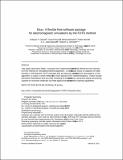| dc.contributor.author | Oskooi, Ardavan | |
| dc.contributor.author | Roundy, David | |
| dc.contributor.author | Ibanescu, Mihai | |
| dc.contributor.author | Bermel, Peter A. | |
| dc.contributor.author | Joannopoulos, John | |
| dc.contributor.author | Johnson, Steven G | |
| dc.date.accessioned | 2011-02-15T13:51:36Z | |
| dc.date.available | 2011-02-15T13:51:36Z | |
| dc.date.issued | 2009-11 | |
| dc.date.submitted | 2009-11 | |
| dc.identifier.issn | 0010-4655 | |
| dc.identifier.uri | http://hdl.handle.net/1721.1/60946 | |
| dc.description.abstract | This paper describes Meep, a popular free implementation of the finite-difference time-domain
(FDTD) method for simulating electromagnetism. In particular, we focus on aspects of implementing
a full-featured FDTD package that go beyond standard textbook descriptions of the
algorithm, or ways in which Meep differs from typical FDTD implementations. These include
pervasive interpolation and accurate modeling of subpixel features, advanced signal processing,
support for nonlinear materials via Pad´e approximants, and flexible scripting capabilities. | en_US |
| dc.description.sponsorship | National Science Foundation (U.S.) (Grant No. DMR-9400334) | en_US |
| dc.description.sponsorship | National Science Foundation (U.S.) (Grant No. DMR- 0819762) | en_US |
| dc.description.sponsorship | United States. Army Research Office. Institute for Soldier Nanotechnologies (Contract No. DAAD- 19-02-D0002) | en_US |
| dc.description.sponsorship | United States. Office of Naval Research (Award N00014-05-1-0700) | en_US |
| dc.language.iso | en_US | |
| dc.publisher | Elsevier | en_US |
| dc.relation.isversionof | http://dx.doi.org/10.1016/j.cpc.2009.11.008 | en_US |
| dc.rights | Attribution-Noncommercial-Share Alike 3.0 Unported | en_US |
| dc.rights.uri | http://creativecommons.org/licenses/by-nc-sa/3.0/ | en_US |
| dc.source | MIT web domain | en_US |
| dc.title | Meep: A flexible free-software package for electromagnetic simulations by the FDTD method | en_US |
| dc.type | Article | en_US |
| dc.identifier.citation | Oskooi, Ardavan F. et al. “Meep: A flexible free-software package for electromagnetic simulations by the FDTD method.” Computer Physics Communications 181.3 (2010): 687-702. | en_US |
| dc.contributor.department | Massachusetts Institute of Technology. Institute for Soldier Nanotechnologies | en_US |
| dc.contributor.department | Massachusetts Institute of Technology. Department of Materials Science and Engineering | en_US |
| dc.contributor.department | Massachusetts Institute of Technology. Department of Mathematics | en_US |
| dc.contributor.department | Massachusetts Institute of Technology. Department of Physics | en_US |
| dc.contributor.department | Massachusetts Institute of Technology. Research Laboratory of Electronics | en_US |
| dc.contributor.approver | Johnson, Steven G. | |
| dc.contributor.mitauthor | Oskooi, Ardavan | |
| dc.contributor.mitauthor | Ibanescu, Mihai | |
| dc.contributor.mitauthor | Bermel, Peter A. | |
| dc.contributor.mitauthor | Joannopoulos, John D. | |
| dc.contributor.mitauthor | Johnson, Steven G. | |
| dc.relation.journal | Computer Physics Communications | en_US |
| dc.eprint.version | Author's final manuscript | en_US |
| dc.type.uri | http://purl.org/eprint/type/JournalArticle | en_US |
| eprint.status | http://purl.org/eprint/status/PeerReviewed | en_US |
| dspace.orderedauthors | Oskooi, Ardavan F.; Roundy, David; Ibanescu, Mihai; Bermel, Peter; Joannopoulos, J.D.; Johnson, Steven G. | en |
| dc.identifier.orcid | https://orcid.org/0000-0001-7327-4967 | |
| dc.identifier.orcid | https://orcid.org/0000-0002-7244-3682 | |
| mit.license | OPEN_ACCESS_POLICY | en_US |
| mit.metadata.status | Complete | |
